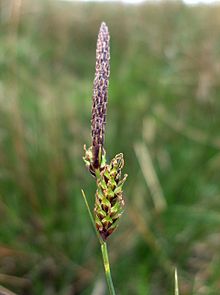Carex gandogeri
| Carex binervis | |
|---|---|
 |
|
| Scientific classification | |
| Kingdom: | Plantae |
| Clade: | Angiosperms |
| Clade: | Monocots |
| Clade: | Commelinids |
| Order: | Poales |
| Family: | Cyperaceae |
| Genus: | Carex |
| Subgenus: | C. subg. Carex |
| Section: | C. sect. Spirostachyae |
| Species: | C. binervis |
| Binomial name | |
|
Carex binervis Sm. |
|
| Synonyms | |
|
|
Carex binervis, the green-ribbed sedge, is a European species of sedge with an Atlantic distribution. It is found from Fennoscandia to the Iberian Peninsula, and occurs in heaths, moorland and other damp, acidic environments. It typically grows to a height of 15–120 cm (6–50 in), and has inflorescences comprising one male and several female spikes, each up to 45 mm (1.8 in) long. The utricles have two conspicuous green veins, which give rise to both the scientific name and the common name of the species. In the vegetative state, it closely resembles C. bigelowii, a species that usually grows at higher altitude. C. binervis was first described by James Edward Smith in 1800, and is classified in Carex sect. Spirostachyae; several hybrids with other Carex species are known.
The culms of Carex binervis are 15–150 centimetres (6 in–4 ft 11 in) tall, although typically less than 120 cm (3 ft 11 in). They are triangular in section with rounded corners and often a single furrow. The leaves are 7–30 cm (2.8–11.8 in) long and 2–6 millimetres (0.08–0.24 in) wide, light green and shiny on the underside, but dark green and matt on the upper surface. The leaves are flat or slightly keeled, and taper abruptly to a fine point.
The roots of C. binervis are 1–2 mm (0.04–0.08 in) in diameter, with the root hairs mostly occurring on the short lateral rootlets. The rhizomes run 25–40 mm (1.0–1.6 in) below the soil surface, and are light brown and approximately 6 mm (0.2 in) in diameter. The whole root system reaches a maximum depth of 18 cm (7.1 in), spreading more widely than Juncus squarrosus, another dominant plant in Atlantic wet heaths.
...
Wikipedia
